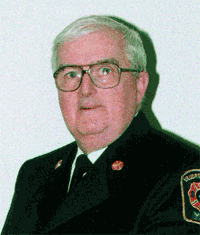
Features
Hot topics
Opinion
Working Fire: The numbers game
It has
been an accepted practice in recent years to suggest a minimum number
of fire fighters required to respond and operate at a fire in a
single-family, one-storey detached dwelling.
December 6, 2007
By Harold Harvey
 It has
It has
been an accepted practice in recent years to suggest a minimum number
of fire fighters required to respond and operate at a fire in a
single-family, one-storey detached dwelling.
The number has
usually been 10, using the following breakdown – command-1, pump
operator-1, initial attack/search/rescue-2, backup-2, rapid
intervention team-2, ventilation-2.
This serves as a good example to illustrate the work required at any ordinary house fire and the personnel required to do it.
Fire
fighters, however, are facing problems with newer type housing, which
has impressive square footage spread over a number of storeys.
In
addition, roofs cannot easily be laddered using the assortment of
ladders usually carried on the attack pumper – a 24- or 35-foot ground
ladder and a 12-foot roof.
Additional problems are confronted
when the building set-back is taken into account, which may require
additional hose lengths beyond reach of the 150- to 200-foot preconnect.
A
line to the rear and one to get to the upper storeys is further proof
that the capacity of the preconnected hosebed – usually 200 feet – will
have to be exceeded.
This can be done by providing one 300-footer or leading off with larger hose and then divide and reduce – the skid load concept.
In
many communities, the size of a newer home is equivalent to a small
apartment building and the initial deployment of a large blitz line may
be called for to calm things down.
A working fire in such
structures will call for an increase in the number of fire fighters
required, which, if not readily available, may force command to
prioritize the tasks to be done using the risk-versus-gain criteria.
Obviously life safety – ours and theirs – must be paramount.
However, with an increased surface area to be checked on different levels, the crews may require additional resources.
There
may be ways and means of ensuring adequate response of personnel by
resorting to an automatic mutual aid response or the sounding of a
general alarm, especially during times when a limited number of fire
fighters is available or the potential for a serious fire is
anticipated.
Indications could include numerous calls being received or a late-night/early-morning call from an excited individual.
The
department may have the luxury of dispatching additional on-duty crews
for what appears to be a potential fire either in an emergency response
mode or move-up of apparatus without using red lights and sirens.
The
response should include at least one elevating device if we hope to
safely and quickly ventilate the structure and, if the unit must be
provided by a mutual aid company, initial units must govern their
placement accordingly, leaving proper access for the aerial.
If
such a vehicle is unavailable, additional fire fighters will be
required to install the ladders that are available and not only assist
in getting people to the roof, but also ensure they are supplied with
the proper tools.
At least four people are required to raise
ladders longer that 35 feet and they must be transported and set up in
all manner of locations and in all weather conditions.
In
addition, roof ladders are required to be set up for the safe operation
of the crews and equipment hoisted or carried up to the workplace.
A secondary means of exit for these work crews is advisable and should be seriously considered at any developing incident.
The
10 fire fighter minimum, if respected, will create a busy fire scene as
there are many more items that may have to be taken care of by these
people – for example the setting up of positive pressure fans for
initial attack and the provision of lighting equipment inside and
outside the structure, as well as the multitude of equipment that may
be required for forcible entry.
The designation of a safety officer should add another fire fighter to the crew. Of
course, we have not factored in the possibility of failure of
equipment, including the pumper supplying the initial attack lines or
some other interruption in the water supply.
A comment can be
made that the use of two fire fighters as a rapid intervention team is
not appropriate and four should be the minimum.
This brings the total to 12 or 13 if we include the safety position.
It
would be also advisable to enter with a three- or four-man crew
allowing an officer to supervise two fire fighters handling the line
and the third using the thermal imaging camera.
We now arrive at 14 to 15 fire fighters as a minimum.
Of course, as stated in the beginning, 10 is only a suggested number and we all realize that we respond to many more "service not required" or "false activation" calls at these dwelling units.
Efforts
are being made to lessen the demand these calls make on the fire
service, but until then larger and taller single-family dwellings will
continue to be constructed, increasing the odds that the next call will
require an extra effort.
Fire fighters should be encouraged to
visit the construction sites in an attempt not only to see how they are
constructed – lightweight construction – but also to determine the
personnel that will be required to do the job.
Play Safe!
Veteran fire instructor Harold Harvey, tpi, recently retired as Director (Fire Chief) of the Vaudreuil-Dorion (Que.) Fire Department. He has devoted 39 years to furthering the mission of the fire service and continues as an advisor and consultant for municipal fire departments. E-mail hkharvey@videotron.ca.
Print this page